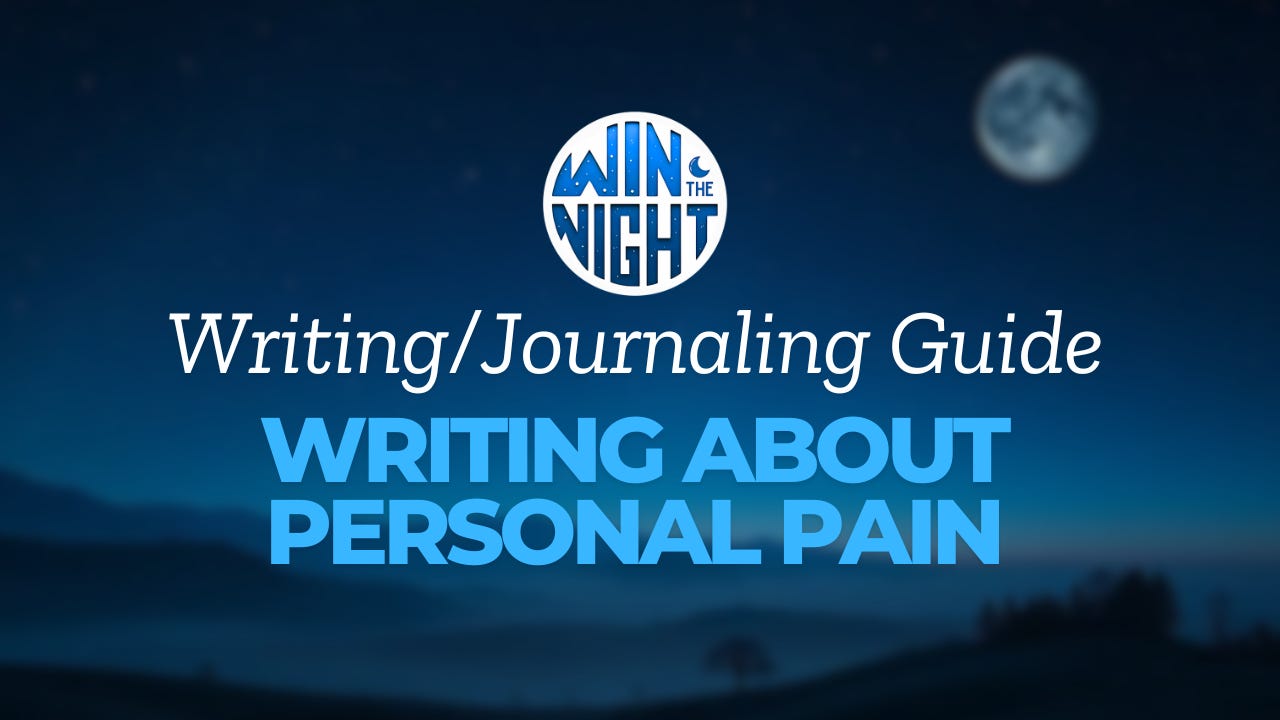How to Write About Pain without Falling Apart.
We romanticize the idea of “bleeding on the page,” but the bleeding just makes a mess. If your writing isn’t helping you move forward, even slowly, it might be time to reassess the way you attack it.
Let’s start with the obvious: writing is supposed to help. That’s what we’re told; journaling is cathartic, getting it all out is the path to peace, if you just keep scribbling through your sadness, eventually it’ll turn into healing.
But sometimes it doesn’t. Sometimes writing makes things worse.
“You just weren’t taught how to write without re-breaking the bone.”
Sometimes, the more you try to “express yourself,” the deeper the spiral.
You end up raw, exhausted, and wondering if this whole emotional growth thing is actually just a scam.
I’ve been there.
I’ve had nights where I’ve written three pages about something that happened when I was 9, only to realize I’ve been stuck in the same narrative loop for ten years. Just with better grammar now.
I've written about the same argument, the same parent wound, the same “I thought I was over this” nonsense more times than I can count. And sometimes all I had to show for it was a headache and a weird feeling in my stomach.
This article is here to break that loop.
Not to stop you from writing, but to help you write smarter. More safely. More intentionally. Because writing can heal, but only if you know when to hold the pen and when to put it down.
Writing can actually hurt you if you don’t know what you’re doing.
Let’s get clinical for a second.
When you write about painful stuff without any grounding, you’re basically giving your nervous system a megaphone and zero boundaries.
You’re asking your brain to relive trauma in full HD without a safety net.
That’s not healing. That’s emotional flooding.
Writing can create clarity, but only if you’re in a place to receive that clarity. If you’re overwhelmed, stressed, or in a dissociative fog? Writing just becomes a maze. You walk in with a flashlight and walk out with a migraine.
What’s worse is when you think you should feel better afterward, but you don’t. You end up blaming yourself. “Why didn’t this help? What’s wrong with me?”
Nothing’s wrong with you. You just weren’t taught how to write without re-breaking the bone. It’s the equivalent of trying to do physical therapy on a broken leg without a brace, no instruction, and no one to spot you.
Then blaming yourself when it hurts worse than before.
You might be journaling in a way that’s making things worse.
Here’s the checklist nobody gives you:
You feel worse after writing
You’re writing the same story on loop
You keep chasing a catharsis that never comes
You use journaling as a substitute for confrontation, clarity, or therapy (hi, it’s me)
You treat the journal like a void that will swallow your pain and solve your problems, only to find it keeps echoing them back
You finish your entries with less energy, more anxiety, and a vague sense of failure
We romanticize the idea of “bleeding on the page,” but sometimes all that bleeding just makes a mess.
If your writing isn’t helping you move forward, even slowly, it might be time to reassess the way you’re doing it.
There is a way to write that won’t spiral you out.
Here’s the system I use. Not perfect. But it works.
Step 1: Set a boundary before you begin.
Say your goal out loud.
“I’m writing to understand, not to relive.”
If you say it like a weirdo in the mirror, even better.
Step 2: Start with your body, not your brain.
Before you write, check in physically.
Breathe. Roll your shoulders. Stretch your jaw.
Look around the room and name five things you see.
You're not back there. You're here.
Let your nervous system know that.
Step 3: Stay aware while writing.
If you feel numb, detached, or suddenly anxious, pause.
That’s not failure. That’s feedback.
Ask yourself:
Is this helping me see something, or just feel something I already know?
Step 4: End with a redirect.
Don’t just slam the laptop shut and stew.
Write one thing you need right now:
Water
Peace and quiet
A short nap
A snack
A hug
Then go do it.
Step 5: Do something physical.
Writing is cerebral. Trauma lives in the body.
Get up. Walk. Shake your arms. Reconnect.
For me, I only work on one article at a time.
That’s my version of pacing.
I don’t stack projects, I don’t try to tackle five different pieces of my healing at once.
I stay with one thing, give it space, and finish it on my own terms.
Because if I try to do more than I can handle, I just shut down.
These steps don’t make writing safe every time, but they raise your chances of coming out the other side with your soul intact.
Some prompts can help you write without collapsing.
Most journaling prompts are written by people who assume you’ve had a good breakfast and eight hours of sleep.
Here’s a set of journaling/thought prompts that meets you where you’re at:
“What’s the one thing I don’t want to admit I’m feeling right now?”
“What’s something that’s true, even if I don’t like it?”
“If my emotions could talk, what would they be asking me for?”
“What would I write if I didn’t have to show this to anyone, including myself?”
“What would future-me thank me for writing today?”
These prompts aren't about ripping your soul open.
They’re about knocking gently and saying hey, what’s going on in there?
You don’t need to solve your entire childhood in one sitting.
You just need to make contact.
If writing feels unsafe, there are other ways to process.
Sometimes writing just isn’t the move.
That’s not avoidance. That’s regulation. Big difference.
Here are some writing alternatives that still let you process without frying your circuits:
Voice notes – Hit record, talk freely, delete it after. It’s like writing without the hand cramps and existential dread.
Emotion-only check-ins – List your emotions like ingredients. “Tired, annoyed, hopeful, jealous, wired.” No story. Just name and notice.
Micro-movements – Try rocking, shaking your hands, pacing. Your body’s been through it too.
Soundtrack therapy – Put on a song that hits where you're at and let it move through you. Bonus points if it’s dramatic.
Visual venting – Doodle. Scribble. Use colors. Make angry shapes. This is especially good if you feel stuck in your head.
Wait 24 hours – If you’re too close to it, wait. If it still wants to be written tomorrow, it will.
This is the ritual I use when I know I’m writing something heavy
Here’s what I do when I know I’m about to dive into some heavy stuff:
Set the stage: music, a background noise tv show (like the office), or even just sitting in a space that feels grounded.
I say to myself something along the lines of “You don’t have to solve this. You just have to name it.”
I only work on one article at a time. That’s how I keep it manageable. One emotional thread, one tab open in my brain.
When I finish, I don’t linger in it. I close the laptop and remind myself that that’s enough for now.
I walk around my living room, get a drink, have a dance party with my kid, watch something dumb. Reconnect to life.
It sounds a little over-the-top, but that’s kind of the point.
Treat it like ritual, not like homework. It deserves that kind of care.
You don’t need to bleed on the page to heal
Writing should be a flashlight, not a shovel.
You’re not here to dig yourself deeper. You’re here to illuminate what’s there and get out safely.
You don’t have to be productive with your pain. You don’t have to make art from it. You don’t have to wring meaning from it every time. Sometimes pain is just pain, and that’s okay.
You’re still here. Still trying.
Still turning the chaos into coherence, even if it’s just for a few minutes at a time.
That counts for a lot.
Especially here.






I pace like a mad person when I write. It gives me clarity to pen the words that keeps escaping when I sit down.
Beautiful post of direction.